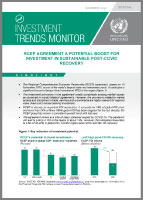
The Regional Comprehensive Economic Partnership (RCEP) agreement, signed on 15 November 2020, is one of the world’s largest trade and investment pacts. It could give a significant boost to foreign direct investment (FDI) in the region.
The investment provisions in the agreement mostly consolidate existing market access as contained in myriad bilateral agreements. However, the provisions related to market access and disciplines in trade, services and e-commerce are highly relevant for regional value chains and market-seeking investment.
The RCEP is already an important FDI destination. It accounts for 16% of global FDI stock and more than 24% of flows. While global FDI has been stagnant for the last decade, the RCEP group has shown a consistent upward trend until last year.
The agreement comes at a time of major upheaval caused by COVID-19. The pandemic will lead to a drop in FDI in the region of about 15%. However, this compares favourably to a fall of 30-40% in global FDI, and the region looks set to lead the FDI recovery.
A key challenge for the RCEP will be to follow through on economic integration efforts at a time of global and intra-regional geopolitical and trade tensions. The global economic recession caused by the pandemic will also limit the potential of RCEP to expand trade, investment GVCs in the short term.
A key opportunity lies in the diversity within the RCEP, which can lift investment prospects through complementary locational advantages and catch-up development potential. Among the members, FDI stock relative to the size of the economy ranges from less than 5% to a multiple of GDP.
Intra-regional investment, at about 30% of total FDI in the RCEP, has significant room for further growth. It is relatively low compared to other major economic partnerships. The ASEAN group, at the heart of the RCEP, will play an important role. Already about 40% of investment in ASEAN comes from RCEP members.
Likely investment policy priorities for the partnership will include:
- Boosting investment in sustainable post-pandemic recovery. This requires investment in infrastructure, clean energy and healthcare, all of which rely on increasing international project finance. The RCEP includes several top source countries for project finance. There is room for growth. For example, the RCEP attracts projects in line with its global FDI share but accounts for only about 12% of projects in renewable energy.
- Supporting resilience-seeking FDI. The need for multinational enterprises to diversify supply sources and strengthen regional value chains should translate not only in shifting FDI patterns within the region but also in renewed overall growth of international investment in industry. Greenfield investment in trade-exposed manufacturing in the region has decreased by more than 40% over the last decade.
- Promoting investment for development. The least developed country signatories Cambodia, Myanmar and Laos respectively receive more than 70%, 80% and 90% of their FDI from other RCEP members. Economic cooperation under the partnership could further boost both project finance in infrastructure and industrial investment to increase their GVC participation.




